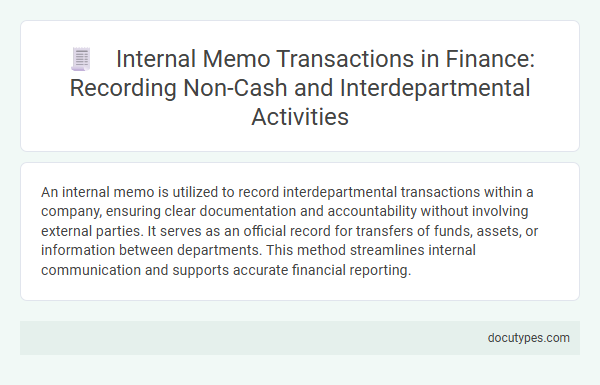An internal memo is utilized to record interdepartmental transactions within a company, ensuring clear documentation and accountability without involving external parties. It serves as an official record for transfers of funds, assets, or information between departments. This method streamlines internal communication and supports accurate financial reporting.
Introduction to Internal Memo Transactions in Finance
| Topic | Details |
|---|---|
| Internal Memo Transactions | A type of financial entry used to record non-cash events or adjustments within an organization's accounting records. |
| Purpose of Internal Memo | Documenting internal financial movements without affecting cash flow, such as asset transfers, inter-departmental charges, or adjustments to budget allocations. |
| Common Usage | Used for recording transactions like internal asset transfers, allocation of internal costs, correction of accounting errors, and budget revisions. |
| Effect on Financial Statements | Adjusts internal accounts but does not impact external cash balances or bank statements directly. |
| Benefits | Ensures transparent, traceable internal financial movements, improves budget control, and aids in accurate internal reporting. |
| Key Entities Involved | Finance department, accounting team, internal auditors, and management responsible for financial oversight. |
| Examples | Reallocation of funds between departments, internal loan records, intercompany billing, and asset reclassification. |
Understanding Non-Cash Transactions in Financial Records
Internal memos are used to document non-cash transactions in financial records, ensuring accurate and transparent accounting. Understanding when to apply these memos is vital for maintaining proper financial control and audit trails.
- Internal Memo Usage - It records non-cash transactions such as asset transfers or internal chargebacks that do not involve external cash flow.
- Non-Cash Transactions - Examples include depreciation adjustments, interdepartmental billing, and inventory reallocations impacting financial statements.
- Your Financial Records - Using internal memos maintains clarity and accountability for transactions that affect account balances without actual cash movements.
The Role of Internal Memos in Financial Documentation
Internal memos play a crucial role in documenting specific financial transactions that require detailed internal communication. These memos are primarily used for recording interdepartmental transfers and internal adjustments within an organization's accounting system.
The role of internal memos in financial documentation ensures transparency and accuracy by providing a formal record of transactions not involving external parties. They help maintain audit trails for internal transactions such as expense reallocations, budget amendments, and corrections to previously recorded entries.
Types of Interdepartmental Activities Requiring Memo Entries
Internal memos play a crucial role in recording specific types of financial transactions within an organization. These memos document interdepartmental activities where no cash exchange occurs but accounting entries are necessary for accurate financial tracking.
- Transfer of Inventory - Internal memos record the movement of inventory between departments to track stock usage and allocation.
- Allocation of Overhead Costs - Departments allocate overhead expenses through memos to ensure proper cost distribution across business units.
- Reclassification of Expenses - Internal memos document adjustments when expenses are shifted between departments for budget accuracy.
Utilizing internal memos for these transactions ensures transparency and precise financial reporting in corporate accounting systems.
Recording Non-Cash Transactions: Best Practices
Which transaction utilizes an internal memo for recording? An internal memo is primarily used for recording non-cash transactions such as asset transfers, loan adjustments, or interdepartmental charges. This practice ensures accurate documentation and transparency within financial records, adhering to internal control standards.
Key Steps for Documenting Interdepartmental Transfers
Internal memos are primarily used for recording interdepartmental transfers within a company. These transactions involve the movement of assets, funds, or resources between departments without external entities.
Key steps include clearly identifying the departments involved and specifying the nature of the transferred items. Documentation must record the date, value, and purpose to ensure accurate internal accounting and audit trails.
Ensuring Accuracy in Internal Memo Transaction Records
Internal memos are primarily utilized for recording interdepartmental or internal financial transactions that do not involve external parties. These memos ensure accuracy by providing detailed documentation of cost allocations, budget adjustments, and internal chargebacks. Your finance team relies on precise internal memo records to maintain transparent and verifiable accounting entries within the organization.
Internal Controls for Memo-Based Transactions
Internal memos are typically used for recording interdepartmental transfers, expense reimbursements, and adjustments within an organization's accounting system. These transactions require strict internal controls to ensure accuracy, authorization, and proper documentation for audit trails. Your finance team relies on these memos to maintain transparency and prevent errors or fraud in memo-based transactions.
Common Challenges in Recording Internal Memo Transactions
Internal memos are commonly used to document transactions within an organization that do not involve external parties, such as interdepartmental transfers or adjustments. You must ensure accuracy and clarity to avoid discrepancies in financial records.
Common challenges in recording internal memo transactions include maintaining consistent documentation standards, accurately capturing transaction details, and ensuring timely entry into financial systems.
- Lack of Standardization - Internal memos often vary in format, leading to confusion and potential misinterpretation in financial records.
- Incomplete Information - Missing critical transaction details can result in inaccurate accounting and reconciliation issues.
- Delayed Processing - Internal memos may not be recorded promptly, causing discrepancies in real-time financial reporting.
Which Transaction Utilizes an Internal Memo for Recording? Infographic

